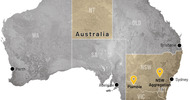Financial Times Investment Adviser | Monday, February 23, 2009
Story by: Anna Lawlor
There is rising interest in agriculture funds, with plenty of investment opportunities – though there is a risk of these funds tipping the other way
Soft commodities, such as grains and livestock, have long been overshadowed by sexier natural resources, such as fuel and base metals. The astronomic rise and fall of these hard commodities last year, along with investors' new-found Puritanism and rejection of speculative strategies, have piqued interest in agriculture funds, a sub-asset class of soft commodities.
A swathe of retail funds were launched in this area towards the end of 2007 and early 2008, including Sarasin AgriSar, Eclectica Agriculture, Castlestone Aliquot Agriculture, Allianz RCM Global Agriculture Trends and Ceres Agriculture Sicav. Baring Asset Management launched its Global Agriculture fund in January and Cru Investment's offshore Africa Transformational Agri fund is scheduled to open on March 31.
Agriculture opportunities are accessed through land purchase (for production of foodstuffs or, more recently, biofuels), through equity investments in companies associated with this theme or – as is the case for £143m Ceres Agriculture fund – through pure derivative strategies.
Direct land purchase is expensive and of limited availability. Most agriculture retail funds are equity-based, thematic propositions that focus on companies along the 'farm-to-fork' spectrum.
For example, Barings' Jonathan Blake, who manages its £60m Global Agriculture fund and the $465.8m (£326.8m) Global Resources Sicav, believes the case for agriculture rests on the three Fs: food, feed and fuel.
The prime drivers for both food and feed can be traced to emerging markets. Mr Blake quotes the United Nations' global population growth forecast from 6.5bn at present to 9.3bn by 2050 – "that's three new mouths to feed every eight seconds". Significant shifts in the dietary behaviour of people from emerging economies, particularly China and India, to protein and dairy-based diets will transform agricultural demand. For example, to produce 1kg of beef takes 8kg of feed, he says.
Nick Smith, managing director at Allianz Global Investors Europe, agrees: "Roughly 2bn people in emerging markets are becoming richer and their demand for food is changing. This type of food production takes much more land and fertiliser. The land area needed to produce 1kg of meat could produce 160kg of potatoes."
US president Barack Obama's support of biofuels and the finite nature of global oil supplies provide a third element to investable opportunities in agriculture.
While the drivers of growth in agriculture may originate in emerging markets, all of the managers interviewed insisted their funds had a truly global reach. The Barings fund is internally constrained by a cap on emerging market exposure at 50 per cent. Mr Blake says the companies responding to emerging market demand tend to be based in Europe or North America.
Henry Boucher, manager of the £67.8m Sarasin AgriSar fund, believes there is a risk of such funds tipping the other way. "Many of my competitors looked at the World index for the sectors that had agriculture, such as MSCI Agricultural chemicals, and just piled in. That plays on productivity gains if you have limited land – fertiliser for plants – but it is a limited way of playing agriculture," he says.
"That became part of last year's bubble, where hedge funds and others played this very narrowly based set of stocks – typically, North American-based, chemicals-orientated – and many structured products were created around that. Entire agriculture indices are dominated by North American chemical stocks."
Mr Boucher takes a "wider understanding" of investment opportunities under the agriculture banner. "Although the fund is called AgriSar and has mostly agriculture in it, there is a lot about food generally, based on issues before you get to the farm and after food reaches the consumer."
Obesity is one theme explored in the fund, with a 2.5 per cent holding in Fresenius Medical Care, a provider of dialysis products. Its 3 per cent investment in Barry Callebaut, the leading chocolate producer, perhaps acts as a hedge.
Mr Blake, whose fund is benchmarked against the MSCI World index, says investors expect farm to fork. "My investors would not expect to see, say, a dialysis company in there."
The Ceres Agriculture fund, domiciled in Guernsey, invests solely in agricultural futures contracts, which it claims minimises portfolio volatility. Chady Achkar, senior portfolio manager, says: "We are trying to extract short and medium-term volatility from the market – whether Monsanto is under- or overvalued, we don't care. It's not about reflecting our personal views."
He says the fund's annual volatility is 5 per cent versus an agriculture market average of 40-45 per cent. In 2008, the fund returned 1.98 per cent compared with a loss of 27.47 per cent from the DJ AIG Agriculture Total Return index. While open to retail investors, the fund is split fairly evenly between pension fund investors and discretionary managers, such as Investec.
There is low correlation between the different elements of agriculture and between the agriculture sector and other asset classes. Mr Achkar points to the correlation demonstrated between copper, zinc and nickel in the metal market, compared with the lack of uniformity between corn and sugar, for example, or cocoa and wheat.
This defensive nature, combined with long-term thematic drivers, appeals to investors and the investment firms launching agriculture funds.
"Food is dependable; the elasticity of demand is low. Most of these companies are cheap now and they have more reliable cash flows, in terms of planting crops and receiving a tangible return, whereas many companies, such as in autos, are not going to achieve that this year," Mr Boucher says. "It's a much more reliable cash-flow harvest and there are different drivers to, say, something linked to German or Japanese industrial production."
However, Hugh Hendry, founder of Eclectica Asset Management, said last month it was a "mistake" to have previously described the farming sector as the "antithesis" of banking. For him, the concept of agriculture decoupling from other sectors has proven illusory. The £94.6m Eclectica Agriculture fund finished last year down 35 per cent. He said: "Part of our enthusiasm for agriculture is that it has been so disconnected from the rest of the world. It's perhaps the only unleveraged area of the investment universe, and I thought it would serve us well in 2008."
With the exception of Ceres Agriculture, which has a 70 per cent allocation to futures contracts of three-month duration or shorter, most managers agree investing in the agriculture theme is a long-term game. For Mr Blake, that means an investment horizon of at least three years; for Mr Boucher it is a "decade-plus trend".
"This isn't about this year's crop or next year's. It's about an increase in the volumes and types of food around the world," Mr Boucher concludes.
Anna Lawlor is deputy features editor at Investment Adviser
Story by: Anna Lawlor
There is rising interest in agriculture funds, with plenty of investment opportunities – though there is a risk of these funds tipping the other way
Soft commodities, such as grains and livestock, have long been overshadowed by sexier natural resources, such as fuel and base metals. The astronomic rise and fall of these hard commodities last year, along with investors' new-found Puritanism and rejection of speculative strategies, have piqued interest in agriculture funds, a sub-asset class of soft commodities.
A swathe of retail funds were launched in this area towards the end of 2007 and early 2008, including Sarasin AgriSar, Eclectica Agriculture, Castlestone Aliquot Agriculture, Allianz RCM Global Agriculture Trends and Ceres Agriculture Sicav. Baring Asset Management launched its Global Agriculture fund in January and Cru Investment's offshore Africa Transformational Agri fund is scheduled to open on March 31.
Agriculture opportunities are accessed through land purchase (for production of foodstuffs or, more recently, biofuels), through equity investments in companies associated with this theme or – as is the case for £143m Ceres Agriculture fund – through pure derivative strategies.
Direct land purchase is expensive and of limited availability. Most agriculture retail funds are equity-based, thematic propositions that focus on companies along the 'farm-to-fork' spectrum.
For example, Barings' Jonathan Blake, who manages its £60m Global Agriculture fund and the $465.8m (£326.8m) Global Resources Sicav, believes the case for agriculture rests on the three Fs: food, feed and fuel.
The prime drivers for both food and feed can be traced to emerging markets. Mr Blake quotes the United Nations' global population growth forecast from 6.5bn at present to 9.3bn by 2050 – "that's three new mouths to feed every eight seconds". Significant shifts in the dietary behaviour of people from emerging economies, particularly China and India, to protein and dairy-based diets will transform agricultural demand. For example, to produce 1kg of beef takes 8kg of feed, he says.
Nick Smith, managing director at Allianz Global Investors Europe, agrees: "Roughly 2bn people in emerging markets are becoming richer and their demand for food is changing. This type of food production takes much more land and fertiliser. The land area needed to produce 1kg of meat could produce 160kg of potatoes."
US president Barack Obama's support of biofuels and the finite nature of global oil supplies provide a third element to investable opportunities in agriculture.
While the drivers of growth in agriculture may originate in emerging markets, all of the managers interviewed insisted their funds had a truly global reach. The Barings fund is internally constrained by a cap on emerging market exposure at 50 per cent. Mr Blake says the companies responding to emerging market demand tend to be based in Europe or North America.
Henry Boucher, manager of the £67.8m Sarasin AgriSar fund, believes there is a risk of such funds tipping the other way. "Many of my competitors looked at the World index for the sectors that had agriculture, such as MSCI Agricultural chemicals, and just piled in. That plays on productivity gains if you have limited land – fertiliser for plants – but it is a limited way of playing agriculture," he says.
"That became part of last year's bubble, where hedge funds and others played this very narrowly based set of stocks – typically, North American-based, chemicals-orientated – and many structured products were created around that. Entire agriculture indices are dominated by North American chemical stocks."
Mr Boucher takes a "wider understanding" of investment opportunities under the agriculture banner. "Although the fund is called AgriSar and has mostly agriculture in it, there is a lot about food generally, based on issues before you get to the farm and after food reaches the consumer."
Obesity is one theme explored in the fund, with a 2.5 per cent holding in Fresenius Medical Care, a provider of dialysis products. Its 3 per cent investment in Barry Callebaut, the leading chocolate producer, perhaps acts as a hedge.
Mr Blake, whose fund is benchmarked against the MSCI World index, says investors expect farm to fork. "My investors would not expect to see, say, a dialysis company in there."
The Ceres Agriculture fund, domiciled in Guernsey, invests solely in agricultural futures contracts, which it claims minimises portfolio volatility. Chady Achkar, senior portfolio manager, says: "We are trying to extract short and medium-term volatility from the market – whether Monsanto is under- or overvalued, we don't care. It's not about reflecting our personal views."
He says the fund's annual volatility is 5 per cent versus an agriculture market average of 40-45 per cent. In 2008, the fund returned 1.98 per cent compared with a loss of 27.47 per cent from the DJ AIG Agriculture Total Return index. While open to retail investors, the fund is split fairly evenly between pension fund investors and discretionary managers, such as Investec.
There is low correlation between the different elements of agriculture and between the agriculture sector and other asset classes. Mr Achkar points to the correlation demonstrated between copper, zinc and nickel in the metal market, compared with the lack of uniformity between corn and sugar, for example, or cocoa and wheat.
This defensive nature, combined with long-term thematic drivers, appeals to investors and the investment firms launching agriculture funds.
"Food is dependable; the elasticity of demand is low. Most of these companies are cheap now and they have more reliable cash flows, in terms of planting crops and receiving a tangible return, whereas many companies, such as in autos, are not going to achieve that this year," Mr Boucher says. "It's a much more reliable cash-flow harvest and there are different drivers to, say, something linked to German or Japanese industrial production."
However, Hugh Hendry, founder of Eclectica Asset Management, said last month it was a "mistake" to have previously described the farming sector as the "antithesis" of banking. For him, the concept of agriculture decoupling from other sectors has proven illusory. The £94.6m Eclectica Agriculture fund finished last year down 35 per cent. He said: "Part of our enthusiasm for agriculture is that it has been so disconnected from the rest of the world. It's perhaps the only unleveraged area of the investment universe, and I thought it would serve us well in 2008."
With the exception of Ceres Agriculture, which has a 70 per cent allocation to futures contracts of three-month duration or shorter, most managers agree investing in the agriculture theme is a long-term game. For Mr Blake, that means an investment horizon of at least three years; for Mr Boucher it is a "decade-plus trend".
"This isn't about this year's crop or next year's. It's about an increase in the volumes and types of food around the world," Mr Boucher concludes.
Anna Lawlor is deputy features editor at Investment Adviser













